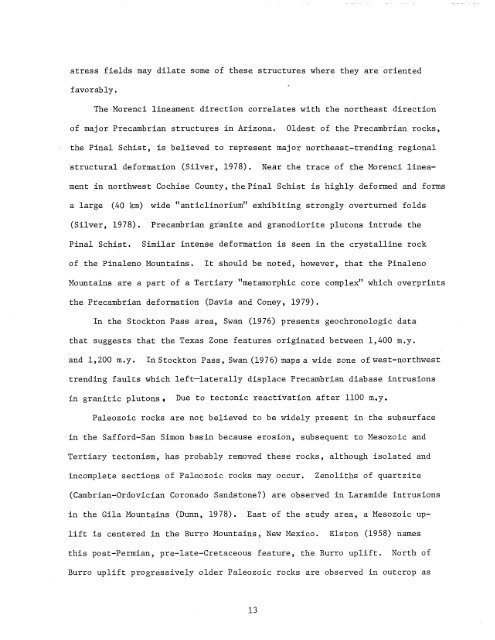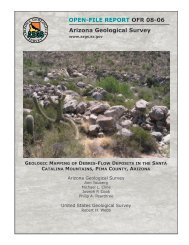geothermal resource potential of the safford-san simon basin, arizona
geothermal resource potential of the safford-san simon basin, arizona
geothermal resource potential of the safford-san simon basin, arizona
You also want an ePaper? Increase the reach of your titles
YUMPU automatically turns print PDFs into web optimized ePapers that Google loves.
stress fields may dilate some <strong>of</strong> <strong>the</strong>se structures where <strong>the</strong>y are oriented<br />
favorably.<br />
The Morenci lineament direction correlates with <strong>the</strong> nor<strong>the</strong>ast direction<br />
<strong>of</strong> major Precambrian structures in Arizona.<br />
Oldest <strong>of</strong> <strong>the</strong> Precambrian rocks,<br />
<strong>the</strong> Pinal Schist, is believed to represent major nor<strong>the</strong>ast-trending regional<br />
structural deformation (Silver, 1978).<br />
Near <strong>the</strong> trace <strong>of</strong> <strong>the</strong> Morenci lineament<br />
in northwest Cochise County, <strong>the</strong> Pinal Schist is highly deformed and forms<br />
a large (40 km) wide "anticlinorium" exhibiting strongly overturned folds<br />
(Silver, 1978).<br />
Pinal Schist.<br />
Precambrian granite and granodiorite plutons intrude <strong>the</strong><br />
Similar intense deformation is seen in <strong>the</strong> crystalline rock<br />
<strong>of</strong> <strong>the</strong> Pinaleno Mountains.<br />
It should be noted, however, that <strong>the</strong> Pinaleno<br />
Mountains are a part <strong>of</strong> a Tertiary "metamorphic core complex" which overprints<br />
<strong>the</strong> Precambrian deformation (Davis and Coney, 1979).<br />
In <strong>the</strong> Stockton Pass area, Swan (1976) presents geochronologic data<br />
that suggests that <strong>the</strong> Texas Zone features originated between 1,400 m.y.<br />
and 1,200 m.y.<br />
In Stockton Pass, Swan (1976) maps a wide zone <strong>of</strong> west-northwest<br />
trending faults which left-laterally displace Precambrian diabase intrusions<br />
in granitic plutonst<br />
Due to tectonic reactivation after 1100 m.y.<br />
Paleozoic rocks are not believed to be widely present in <strong>the</strong> subsurface<br />
in <strong>the</strong> Safford-San Simon <strong>basin</strong> because erosion, subsequent to Mesozoic and<br />
Tertiary tectonism, has probably removed <strong>the</strong>se rocks, although isolated and<br />
incomplete sections <strong>of</strong> Paleuzoic rocks may occur.<br />
Zenoliths <strong>of</strong> quartzite<br />
(Cambrian-Ordovician Coronado Sandstone?) are observed in Laramide intrusions<br />
in <strong>the</strong> Gila Mountains (Dunn, 1978). East <strong>of</strong> <strong>the</strong> study area, a Mesozoic uplift<br />
is centered in <strong>the</strong> Burro Mountains, New Mexico.<br />
Elston (1958) names<br />
this post-Permian, pre-late-Cretaceous feature, <strong>the</strong> Burro uplift.<br />
North <strong>of</strong><br />
Burro uplift progressively older Paleozoic rocks are observed in outcrop as<br />
13

















